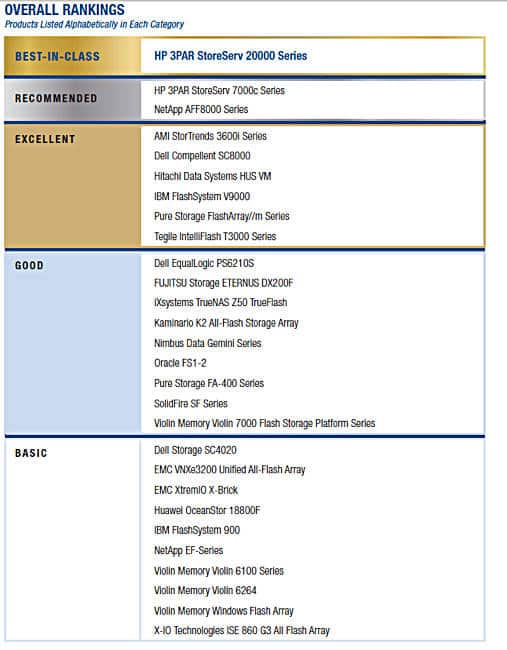Last week DCIG published their "2015-16 All-Flash Array Buyer’s Guide." We've grown accustomed to ignoring most "Magic" and "Best Of" quadrants and awards respectively because almost every time they're garbage. Analysts or media members anoint some vendor or technology best, shiniest, most rectangle or whatever else they can come up with to promote their own brand. What's worse are the awards that are paid for, an even more disturbing part of enterprise IT sales and marketing. But I digress; the task at hand is to figure out how DCIG can pose as industry experts when their own report indicts them as suspicious actors. Let's break it down.
First off, we would have missed this little gem of ineptitude had it not been for The Register who shared the table from the DCIG report. Below is a summary ranking a variety of flash arrays and hybrids that can be configured as flash.

The results are so laughable that it's hard to figure out where to start, so I'll just work top to bottom. Oh and it's worth mentioning that the rubric for scoring these all flash arrays doesn't include any performance or capability testing and in all likelihood the author(s) never used or at least spent any extensive time on the systems.
- Best-in-class: Hard to argue against HP here, except to say that they're fifth in Gartner's volume numbers, well behind EMC's tally. HP is making great strides from a sales perspective though and the 3PAR platform is very mature by comparison of much of the rest of this list.
- Recommended: Similar thoughts here; though we've handled neither array, both have deep customer bases in the traditional array side.
- Excellent: This is where the results get fun. AMI, whose hybrid array we really loved, makes the cut, although they're not yet GA with the 3600i. That's somewhat interesting; a product that's not shipping widely is rated excellent. Huh. The rest of the list makes some degree of sense, though without empirical data the comparisons are difficult. There's also a massive swing in price band between the top and bottom of the systems listed.
- Good: Some of these systems are actually good. While we haven't tested the EqualLogic all-flash configuration, we've seen a couple of the hybrid models and they offer some of the deepest software integration points of any storage array in the market. The Fujitsu is another nice array, but doesn't have much on the data services side and the scalability is an issue. The iX is interesting, we don't hear a lot of demand for open-source all flash arrays that require a lot of tuning, but okay. As a company Violin is struggling mightily, but the 7000-series arrays are incredibly fast. While light on data services for those who care more about speed than anything else, hard to imagine the 7000 just being "good." Nimbus hasn't released a new product in a very long time and their LinkedIn workforce appears to be under 10 people. That doesn't inspire a ton of confidence, despite the fact that the company can probably motor along for a while, given the lack of VC funds invested. The rest of the list suffers from several other "huh?" head scratchers as well, but there's no time. The juicy bits are at the bottom.
- Basic: Times like this require Urban Dictionary, which defines basic as "Unsophisticated," which aptly describes the results in this category. Working top to bottom, the Dell SC4020 is arguably an excellent middle market fit for those who don't need the larger SC8000 but want to stay in the Compellent family. The VNXe3200 was excellent as a hybrid array. While it won't benefit a ton from all flash, it's as fast as larger VNX arrays and easier to manage, great for the edge. If the XtremIO system is basic, than $1 billion in bookings in a year and a half is apparently chump change. The market leader (by a massive margin) is basic. WTF seems appropriate here, yet the gravitas of WTF feels lacking. Skipping down a few more dissed vendors, the Violin Windows array may be somewhat basic in that it runs Windows and that's well, Windows. But make me a list of AFAs that run Windows. If you need that kind of thing, then well, the WFA solves more than a basic need. Lastly the X-IO 860, which we've been reviewing, has handily been the best performer in our lab to date. Couple that with the ease of management/maintenance and the offering is pretty compelling. Hard to know that by looking at glossy spec sheets though.
The other big thing missing from all of this is any consideration for use case. Surely the best-in-class 3PAR is not the best fit for someone growing into flash and looking for budget systems. Overall reports like this do a tremendous disservice to the industry and highlight the overall lack of credibility the industry has as a whole. You can bet HP will take advantage of this report and wave their flag as "2 of the top 3 BEST AFAs!!!!" Pretty much everyone else though will sigh and wave the report off as the chaff it is. If you're looking for a flash array, start with this list, then intelligently remove those that don't fit your needs or budget since DCIG didn't do that for you. Then get the systems in and do a PoC for yourself. That's the surest way to success as this storage industry goes through one of the most significant changes in some time. Oh, and don't forget about SDS/HCI, they do flash too!




 Amazon
Amazon